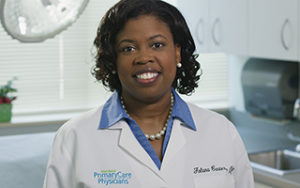Category Archives: Health & Wellness
Board Certified for Better Care
By: Michael Riebman, MD and MPCP President
If you look at the online profiles of our doctors, you’ll see they are “board certified” in Family Medicine, Internal Medicine, or Cardiology. This is an important distinction for physicians, and it gives you additional assurance that you and your family are receiving the best possible care.
A little background: To practice medicine, doctors must undergo years of rigorous training, including a premedical college degree, a degree from a medical school, and up to five years of full-time experience in a residency training program of their chosen specialty. Only after completing all these requirements are they able to practice medicine in the community.
Once they complete their specialty residency program, physicians can demonstrate extra expertise in their chosen medical specialty by earning a certification through one of the 24 accrediting organizations belonging to the American Board of Medical Specialties. Certification means a doctor has acquired the extra knowledge and experience to practice a medical specialty, such as Family Medicine, Internal Medicine, or Cardiology.
Doctors earn this board certification by passing an examination administered by the member board in their specialty. The exams assess medical knowledge and clinical judgment, and include real-life situations that demonstrate a physician’s knowledge of the latest medical practices.
Medical boards issue time-limited certifications. Their certifications last for up to 10 years, but doctors have to complete additional work between these re-certifications, known as continuing medical education, such as reviewing their performance on patient care and self-assessing their knowledge of new medical developments.
In short, the re-certification program provides doctors a structured approach to improving the effectiveness of their performance in treating patients. It also assures patients that their doctors remain experts in their fields.
MPCP requires all of our doctors to be board certified. This gives our patients the added assurance they’re getting the highest level of care, and that our physicians are committed to keeping their skills sharp and up to date.
 Dr. Riebman is certified by the American Board of Family Medicine and is the current president of Maryland Primary Care Physicians. He sees patients in MPCP’s Annapolis office.
Dr. Riebman is certified by the American Board of Family Medicine and is the current president of Maryland Primary Care Physicians. He sees patients in MPCP’s Annapolis office.
Heart Disease Q&A: Knowing Your Numbers
With Dr. Falana Carter
Q: What does “knowing my numbers” have to do with heart disease?
A: We all have our numbers, like cholesterol levels, blood pressure, weight, and blood sugar. Those numbers can tell an important story about your risk for heart disease.
Heart disease is any disorder of the heart muscle, valves, rhythm or blood flow to the heart. Today in the U.S., heart disease is the number one cause of death among both men and women. So knowing your numbers is an important part of your health story. It’s also the first step to reducing your risk of heart disease.
Q: Isn’t heart disease something out of our control – you get it or you don’t?
A: There are two types of risk factors: things you can’t control and things you can. The things you can’t control are your genes: they may predispose you for high blood pressure, high cholesterol or diabetes. If you have a family history of these health conditions, you may be at greater risk for heart disease.
However, there are things you can control, including blood pressure, blood sugar, your weight, cholesterol levels, and smoking. Getting them under control reduces your risk of heart disease. In fact, lifestyle changes can reduce your risk up to 60 percent – and that’s without medication!
Q: What changes should I make?
A: There’s a lot you can do. These things will improve your heart health, as well as giving you better health overall:
- Quit smoking. For people who quit, their risk of heart attack falls to the same level as nonsmokers in just two years.
- Improve cholesterol levels. Cholesterol in your blood includes LDL (bad) cholesterol, HDL (good) cholesterol and triglycerides. A healthy diet and exercise are key to managing cholesterol, though some people may also need medicine.
- Get active. Just 30 minutes of exercise four to five times a week can reduce your risk for heart disease by 30 percent. Exercise reduces your blood pressure and blood sugar. It also helps control your weight and lowers your cholesterol levels.
- Control high blood pressure. Exercise and healthy eating, as well as avoiding salt, are keys to controlling blood pressure, but some people may also need medicine.
- Follow a heart-healthy diet. Eat more foods that are low in fat and cholesterol, including fruits, vegetables, whole grains, beans, nuts and legumes. These foods are high in fiber, which is good for healthy cholesterol, and contain many nutrients.
Eat lean meats, poultry and fish (especially salmon or tuna, which are high in omega-3 fatty acids). And – very important – reduce your intake of salt and sugar.
- Get to a healthy weight. Losing extra weight is good for your heart and can help lower high blood pressure and manage diabetes.
- Control diabetes. Many people who have diabetes don’t know it, so get tested and treated.
- Manage stress and anger. Everyone has stress and anger sometimes, but if it happens a lot, it can damage your heart. Managing stress and handling anger in healthy ways makes you and your heart feel better.
See your doctor to learn what your numbers are, and how they impact your heart health. Your physician can also help you make healthy lifestyle changes and manage your risk factors. Knowing your numbers and getting them under control can help the story of your heart be a long and happy one – for you and your family.
 Dr. Carter is an MPCP partner and is certified by the American Board of Family Physicians. She sees patients at the Arundel Mills office.
Dr. Carter is an MPCP partner and is certified by the American Board of Family Physicians. She sees patients at the Arundel Mills office.
Taking Control of Your Heart Disease Risk
We all have our numbers – like cholesterol levels, blood pressure, weight and blood sugar. But did you know that those numbers can tell an important story about your risk for heart disease? It’s true.
Heart disease is any disorder of the heart muscle, values, rhythm, or blood flow to the heart. Today in the U.S., heart disease is the number-one cause of death among men and women, so knowing your numbers is an important part of your story. It’s also the first step to reducing your risk of heart disease.
There are two types of risk factors – things you can control and things you can’t.
The things you can control are blood pressure, blood sugar, your weight, cholesterol levels and smoking. Getting these under control reduces your risk of heart disease.
The things you can’t control are your genes, if you have a family history of high blood pressure, high cholesterol, or diabetes. That puts you at a greater risk.
Just 30 minutes of exercise 4-5 times a week can reduce your risk by 30%. Exercise reduces your blood pressure and blood sugar. It helps control your weight and lowers your cholesterol levels. Fact is, lifestyle changes like getting active, eating healthy, and quitting smoking can reduce your risk up to 60%. And that’s without medication.
We all have our numbers. Knowing yours and getting them under control can help the story of your heart be a long and happy one for you and your family.
 Dr. Carter is an MPCP partner and is certified by the American Board of Family Physicians. She sees patients at the Arundel Mills office.
Dr. Carter is an MPCP partner and is certified by the American Board of Family Physicians. She sees patients at the Arundel Mills office.
Bad Tick Season May Lead to More Lyme Disease
By: Dr. George Cavanagh
Following a mild winter, Maryland’s tick population was expected to explode this summer. This could lead to a record number of Lyme disease infections in 2019.
Warmer winters allow black-legged ticks, which are the chief carriers of Lyme disease, to remain active longer and spread the illness into new regions of the country. Maryland gets about 1,300 cases of Lyme disease each year, but that number may climb this year.
Lyme Disease Symptoms
Bites from infected ticks often leave a bull’s-eye-shaped rash: a red spot surrounded by white and red circles. Symptoms of Lyme disease include flu-like symptoms (fever, chills, fatigue, body aches and headache), facial paralysis and swollen knees. If left untreated, Lyme can progress to more serious issues like memory problems, heart rhythm irregularities and chronic arthritis.
Not every tick bite leads to Lyme disease, especially if you get them off soon, but if you are bitten by a black-legged tick, see your doctor for antibiotics to treat the illness.
Tips for Prevention
- Avoid areas with high grass, brush and leaf clutter.
- Wear light-colored clothing, long sleeves and closed-toe shoes when hiking. Tuck your pants into your socks, too.
- Use insect repellent containing permethrin to treat your clothes and shoes. Use repellent with DEET, picaridin or IR3535 on your skin
- If you’ve been in a tick-prone area, thoroughly check your body for ticks and shower as soon as possible once indoors.
- Put your clothes in the dryer on high heat for at least 10 minutes to kill any ticks on them.
- If you find a tick, remove it with tweezers immediately.
- Call your doctor if you experience any of the symptoms listed above after removing a tick.
- Check dogs and cats for ticks frequently, and ask your veterinarian about tick preventives.
As a general rule, if you spend time outdoors in an area prone to ticks, assume you’ve picked one up. Do a thorough check when you’re back indoors and remove any ticks immediately.
 Dr. Cavanagh is a Maryland Primary Care Physicians partner and is certified by the American Board of Family Medicine. He sees patients in MPCP’s Bowie office.
Dr. Cavanagh is a Maryland Primary Care Physicians partner and is certified by the American Board of Family Medicine. He sees patients in MPCP’s Bowie office.



